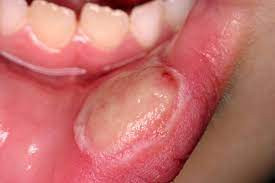Definisi
Ulkus atau granuloma piogenik atau juga dikenal sebagai pyoderma gangrenosum adalah kondisi langka yang ditandai dengan luka (ulkus) pada kulit yang membesar dengan cepat dan sangat nyeri. Ulkus paling sering timbul pada kulit tungkai. Ulkus pyoderma gangrenosum dapat berkembang dengan cepat, namun biasanya dapat sembuh dengan terapi dengan meninggalkan bekas luka dan tidak jarang menjadi kambuh.
Penyebab
Penyebab pasti pyoderma gangrenosum belum diketahui, namun diperkirakan akibat kelainan dari system imun dimana terdapat respon berlebihan terhadap antigen dalam tubuh. Kondisi ini tidak disebabkan oleh infeksi dan tidak menular. Seringkali pyoderma gangrenosum dikaitkan dengan penyakit autoimun seperti colitis ulseratif, penyakit Chron’s, dan artritis rematik. Selain itu, diperkirakan ada faktor genetik yang berperan dalam timbulnya kondisi ini.
Pada penderita pyoderma gangrenosum, adanya cedera pada kulit, misalnya akibat goresan, sayatan, atau luka tusuk, dapat mencetuskan timbulnya ulkus baru. Selain itu, penggunaan beberapa obat juga dapat mencetuskan pyoderma gangrenosum, misalnya kokain, isotretinoin, propiltiourasil, dan sunitinib.
Faktor Risiko
Terdapat beberapa faktor yang dapat meningkatkan risiko seseorang untuk terkena pyoderma gangrenosum, misalnya:
- Usia. Pyoderma gangrenosum dapat meyerang semua kelompok usia, namun lebih sering ditemukan pada orang yang berusia lebih dari 50 tahun. Kondisi ini sangat jarang ditemukan pada anak-anak.
- Memiliki kondisi medis terentu seperti:
- Penyakit usus inflamatori (inflammatory bowel disease/IBD), yang terdiri dari colitis ulseratif dan penyakit Chron’s. Pyoderma gangrenosum merupakan penyebab terbanyak kedua dari gejala kulit pada penderita IBD (1-3%). Kondisi ini lebih sering terjadi pada colitis ulseratif dibandingkan dengan penyakit Chron’s. Saat terjadi episode pyoderma gangrenosum, 50% penderita juga sedang mengalami IBD yang aktif. Setelah IBD mendapatkan penangananpun, pyoderma gangrenosum belum tentu akan mereda.
- Artritis rematik (radang sendi rematik)
- Kelainan darah, misalnya mielogenik akut, mielodisplasia, atau kelainan mieloproliferatif, serta kanker darah
- Gammopati monoklonal
- Hepatitis kronis aktif
- Granulomatosis dengan polyangiitis
- Sindrom PAPA
- Penyakit Bechet
- Tumor
Sekitar setengah dari penderita pyoderma gangrenosum memiliki salah satu faktor risiko di atas.
Gejala
Gejala pyoderma gangrenosum biasanya muncul secara tiba-tiba, seringnya pada lokasi kulit yang mengalami kerusakan. Gejala biasanya dimulai dengan adanya benjolan kecil kemerahan pada kulit, yang dapat menyerupai gigitan serangga. Dalam beberapa hari, benjolan ini dapat menjadi luka terbuka yang besar dan sangat nyeri. Luka ini dapat membesar dan bertambah dalam dengan cepat. Karakterisik dari ulkus pyoderma gangrenosum adalah pinggir atau batas ulkus yang keunguan.
Ulkus biasanya terdapat pada tungkai, meskipun dapat timbul pada bagian tubuh manapun. Terkadang, luka juga dapat timbul pada daerah luka operasi. Beberapa ulkus dapat bertambah besar dan bergabung menjadi satu ulkus yang lebih besar. Jika tidak diterapi, ulkus dapat bertambah besar, tidak berubah, atau dapat sembuh perlahan.
Diagnosis
Untuk mendiagnosis pyoderma gangrenosum, dokter akan menanyakan mengenai riwayat kesehatan Anda dan melakukan pemeriksaan fisik terhadap ulkus yang memiliki bentuk yang karakteristik disertai dengan nyeri berat. Tidak ada pemeriksaan tambahan yang dapat mengkonfirmasi diagnosis pyoderma gangrenosum. Namun, dokter mungkin akan melakukan berbagai pemeriksaan untuk menyingkirkan kemungkinan adanya penyebab lain yang dapat menimbulkan ulkus yang serupa. Pemeriksaan ini dapat meliputi pemeriksaan darah, biopsi kulit, dan lain-lain.
Tata Laksana
Terapi pyoderma gangrenosum bertujuan untuk mengurangi peradangan, mengontrol nyeri, memfasilitasi penyembuhan luka, serta mengontrol kondisi medis yang mendasari. Terapi biasanya sukses untuk menghentikan proses penyakit, namun penyembuhan yang komplit dapat membutuhkan waktu hingga beberapa bulan, terutama jika terdapat penyakit vena.
Terapi yang akan diberikan bergantung pada beberapa faktor, seperti kesehatan tubuh serta jumlah, ukuran, kedalaman, dan kecepatan pertumbuhan ulkus pada kulit. Penanganan terutama difokuskan dengan pendekatan non bedah.
Beberapa orang memberikan respon yang baik terhadap kombinasi terapi menggunakan obat minum, krim, atau suntik. Namun, beberapa membutuhkan perawatan inap di rumah sakit atau pusat perawatan luka. Setelah terapi sukses, seringkali terjadi pembentukan ulkus baru.
Obat-obatan yang dapat diberikan untuk menangani pyoderma gangrenosum antara lain adalah:
- Kortikosteroid. Terapi pyoderma gangrenosum yang paling sering digunakan adalah kortikosteroid harian. Obat ini dapat dipakai dengan mengaplikasikan pada kulit, menyuntikkan pada luka, atau diminum. Namun, penggunaan kortikosteroid dalam jangka Panjang atau dengan dosis yang tinggi dapat menyebabkan efek samping yang serius. Olleh karena itu, dokter mungkin akan meresepkan obat nonsteroid untuk mengurangi penggunaan kortikosteroid jika Anda membutuhkan terapi jangka Panjang
- Obat nonsteroid. Contoh obat nonsteroid yang efektif untuk pyoderma gangrenosum adalah siklosporin. Pilihan lainnya adalah mikofenolat mofetil, dapson, azatioprin, tetrasiklin, larutan kalium iodide, metotreksat, siklosfosfamid, klorambusil, infliximab, tacrolimus (penghambat kalsineurin), immunoglobulin intravena, dan plasmafaresis. Cara penggunaan obat tersebut berbeda beradasarkan jenis obatnya, ada yang diaplikasikan ke kulit, disuntikan, atau diminum
- Obat nyeri. Bergantung pada tingkat keparahan ulkus, obat nyeri mungkin dapat bermanfaat untuk mengurangi nyeri, terutama ketika sedang dilakukan perawatan luka (ganti verban)
Selain obat-obatan, dibutuhkan juga perawatan luka oleh dokter atau ahli perawatan luka. Jaringan mati akan dibuang secara perlahan. Luka akan ditutup dengan verban yang tidak lengket dan lembap (tidak kering dan tidak basah), dan mungkin juga digunakan pembungkus elastis. Dokter mungkin akan meminta Anda untuk mengangkat bagian yang sakit lebih tinggi. Penting untuk mengikut rekomendasi dokter mengenai cara merawat luka. Hal ini karena penderita pyoderma gangrenosum biasanya mengkonsumsi obat yang menekan system imun sehingga meningkatkan risiko untuk infeksi. Infeksi pada luka akan memperambat penyembuhan.
Oleh karena gejala pyoderma gangrenosum dapat menjadi lebih berat akibat adanya kerusakan kulit, maka pembedahan atau operasi untuk membuang jaringan mati tidak disarankan dan tidak dianggap sebagai pilihan terapi yang tepat, terutama pada penyakit yang sedang aktif. Pada pembedahan, akan teradi kerusakan pada kulit yang akan memperparah ulkus yang sudah ada atau mencetuskan timbulnya ulkus baru.
Jika ulkus pada kulit Anda besar dan memerlukan terapi untuk penyembuhannya, dokter mungkin akan menyarankan prosedur skin graft. Prosedur ini dilakukan dengan menempelkan lembaran kulit atau kulit sintetis di atas luka terbuka. Hal ini dilakukan setelah peradangan pada luka menghilang dan ulkus mulai menyembuh.
Komplikasi
Komplikasi yang mungkin terjadi pada pyoderma gangrenosum adalah infeksi, bekas luka, nyeri yang tidak terkontrol, depresi, dan gangguan fungsi sehari-hari
Pencegahan
Pyoderma gangrenosum tidak dapat sepenuhnya dicegah. Jika Anda menderita kondisi ini, cobalah untuk menghindari hal-hal yang dapat menimbulkan cedera pada kulit, termasuk operasi, yang dapat mencetuskan timbulnya ulkus baru. Selain itu, jika Anda memiliki kondisi medis yang dapat menyebabkan timbulnya ulkus, mengontrol penyakit tersebut dapat membantu untuk mencegah pembentukan ulkus.
Kapan Harus ke Dokter?
Jika Anda memiliki luka di kulit yang nyeri dan membesar dengan cepat, maka sebaiknya Anda berkonsultasi dengan dokter.
Mau tahu informasi seputar penyakit lainnya? Cek di sini, ya!
- dr Anita Larasati Priyono
Pyoderma gangrenosum - Diagnosis and treatment - Mayo Clinic. Mayoclinic.org. (2022). Retrieved 8 June 2022, from https://www.mayoclinic.org/diseases-conditions/pyoderma-gangrenosum/diagnosis-treatment/drc-20350392.
Pyoderma Gangrenosum: Symptoms, Causes, and Treatment — DermNet. Dermnetnz.org. (2022). Retrieved 8 June 2022, from https://dermnetnz.org/topics/pyoderma-gangrenosum.
Schmieder, S., & Krishnamurthy, K. (2022). Pyoderma Gangrenosum. Ncbi.nlm.nih.gov. Retrieved 8 June 2022, from https://www.ncbi.nlm.nih.gov/books/NBK482223/.











